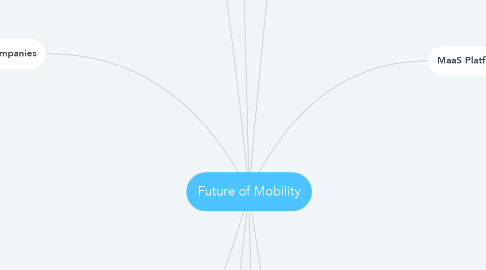
1. Parcel Delivery (inc. last mile)
1.1. Air
1.1.1. Google’s Wing
1.1.2. Amazon
1.1.3. DHL
1.1.4. Drones
1.1.4.1. Flock
1.1.5. UPS
1.1.6. Walmart
1.2. Ground
1.2.1. Robby
1.2.2. Star Ship
1.2.3. Amazon Scout
1.2.4. Nuro
1.2.5. FedEx
1.2.6. Meituan
1.2.7. Budbee
2. Transport Network Companies
2.1. Public Transit Operators
2.1.1. SMRT
2.1.2. JR East
2.1.3. MTA
2.1.4. TFL
2.1.5. Deutsche Bahn
2.1.6. RATP
2.1.7. SFMTA
2.1.8. Citybus
2.2. Ride hailing
2.2.1. Uber
2.2.2. Lyft
2.2.3. Grab
2.2.4. Didi
2.2.5. Gett
2.3. Micromobility
2.3.1. Bird
2.3.2. Ola
2.3.3. Lime
2.3.4. Jump
2.3.5. Skip
2.4. Micro Transit
2.4.1. Viavan
2.4.2. Chariot
2.5. Car sharing or subscription
2.5.1. Blahblah car
2.5.2. Liftshare
2.5.3. Carma Carpooling
2.5.4. Zip car
2.5.5. Sixt
2.5.6. Truro
3. Public Transit Ticketing
3.1. Players
3.1.1. UrbanThings
3.1.2. CoreThree
3.1.3. Cubic
3.1.4. Ticketer
3.1.5. Masabi
3.1.6. Littlepay
3.1.7. BYTEMARK
3.1.8. FlowBird
3.1.9. Conduent
3.1.10. Byte Token
3.1.11. eos - uptrade
3.1.12. Scheidt & Bachmann
3.1.13. Upstream Mobility
3.1.14. Siemens
3.1.15. HaCon
3.1.16. Fairtiq
3.1.17. Telexis
3.1.18. Moovel
3.1.19. Waltz
3.1.20. Wizway Solutions
3.1.21. Token Transit
3.1.22. Fara
3.1.23. Ridango
4. Market Dynamics
4.1. COVID-19 the new norms (commuting trends) and opportunities
4.1.1. Demand driven, not supply
4.1.2. Digitisation accelerated
4.1.3. Dynamic Scheduling
4.1.4. First and Last Mile
4.1.5. Employer MaaS
4.2. UK
4.2.1. Future Mobility Zones Fund
4.2.2. Micromobility pilots
4.2.3. Rail franchising ending
4.3. Business Model for MaaS
4.3.1. Platform licensing
4.3.2. Ticket commisions
4.3.3. Last/First mile commissions
4.3.4. Advertising
4.3.5. Extended travel chain - coffee, restaurants, hotels, trips, insurance
4.3.6. Selling mobility behaviour data for planning, consumer behaviour etc..
4.4. MaaS Platforms forecast to replace urban private journeys (2.3b / year)
4.5. Micromobility 530% growth in 2018
4.6. Arms race to Aggregate All Modes & Payment (tech and ride hailing giants)
4.7. Ticketing and MaaS platform partnerships/acquisitions (Kyyt, Mooviti)
4.8. TNCs chasing daily usage
4.9. Apple investing billions in maps app
4.10. Traditional Car Manufactures & consultancy firms making acquisitions
4.11. Cities offering free public transit (or even pay) - UBM
4.12. Many apps to get from a to b - wanting to own customer
4.13. Walled Gardens or Open Transport System
4.14. Data Privacy & Trust - edge computing
4.15. Business model hard for B2C only solutions e.g. Citymapper, Transit
4.16. Monetise the Destination -"mobility as a platform" - insurance, retail, entertainment - JR East plan
4.17. Urban Planning (active miles)
4.18. Public Transit Ridership lost to TNCs
4.19. Cities slow moving decision making
4.20. PPP - trust & incentive alignments
4.21. Better management of public space
5. Autonomous Vehicle companies
5.1. Wayve
5.2. Voyage
5.3. Waymo
5.4. Five
5.5. Cruise (GM)
5.6. Argo AI
5.7. Tesla
5.8. Baidu
5.9. Apple
5.10. Lyft
5.11. Uber
5.12. Zoox
5.13. Car Manufacturers
5.13.1. BMW
5.13.2. Audi
5.13.3. Daimler
5.13.4. VW
5.14. Ecosystem
5.14.1. Phantom Auto
5.14.2. Cognata
5.14.3. Perceptive Automata
5.14.4. Humanising autonomy
5.15. Business Models
5.15.1. Licensing
5.15.2. Robotaxies
6. Transport Network Intermediaries (B2C)
6.1. Players
6.1.1. Tech Giants
6.1.1.1. Google Maps
6.1.1.2. Apple Maps
6.1.2. Ride Hailing
6.1.2.1. Uber
6.1.2.2. Lyft
6.1.3. Transit Apps
6.1.3.1. Citymapper
6.1.3.2. The Trainline
6.1.3.3. Transit App
6.1.3.4. Moovit
6.1.3.5. WhereIsMyTransport
6.1.3.6. Cowlines
6.1.3.7. Pigeon app
6.1.3.8. Chalo
6.1.4. MaaS Apps
6.1.4.1. Jelbi
6.1.4.2. Whim
7. Mapping Data & Platforms
7.1. Transit Data
7.1.1. Ito World
7.1.2. Swiftly
7.1.3. Optibus
7.1.4. TransportAPI
7.2. High definition maps
7.2.1. Carmera
7.2.2. Deep map
7.3. Standard maps
7.3.1. HERE
7.3.2. Tomtom
7.3.3. OpenStreetmap
7.3.4. Mapillary
7.4. Platforms
7.4.1. Bing
7.4.2. Google
7.4.3. Mapbox
8. Smart Cities
8.1. Mobility Management
8.1.1. Populous
8.1.2. Remix
8.1.3. Optibus
8.1.4. Go Urban
8.1.5. Ride Report
8.1.6. Vianova
8.1.7. Immense
8.1.8. Wunder Mobility
8.2. Fleet Management Platforms
8.2.1. SpareLabs
8.2.2. iomob
8.2.3. Joyride
8.2.4. Ridecell
8.2.5. Best Mile
8.2.6. Wunder Mobility
8.2.7. Arity
8.2.8. DemandTrans
8.2.9. LiftanGo
8.3. Curb Management
8.3.1. Coord
8.3.2. Appyway
8.3.3. curbFlow
8.3.4. Numina
8.3.5. Vade
8.3.6. Coding the curbs
8.4. Usage Based Products
8.4.1. Metromile
8.5. Platforms
8.5.1. Intel
8.5.2. Siemens
8.5.3. IBM
8.6. Behaviour Change
8.6.1. Miles App
8.6.2. Betterpoints
8.6.3. Velios
9. MaaS Platforms
9.1. Players
9.1.1. UK
9.1.1.1. UrbanThings
9.1.1.2. Passenger
9.1.1.3. Bushub
9.1.1.4. TravelAI
9.1.1.5. Number8
9.1.1.6. Signalbox
9.1.1.7. TransportAPI
9.1.1.8. Karhoo
9.1.1.9. Rygo / utrack
9.1.1.10. Mobile Onboard
9.1.1.11. Zeelo
9.1.2. Axon Vibe
9.1.3. HopOn
9.1.4. Motion Tag
9.1.5. Moovit (Intel and Cubic partner)
9.1.6. Transit
9.1.7. Wunder Mobility
9.1.8. MaaS Global
9.1.9. Skedgo
9.1.10. WhereIsMyTransport
9.1.11. kyyti (Masabi partnership)
9.1.12. Trafi
9.1.13. ReachNow
9.1.14. HaCon (Siemens)
9.1.15. SkedGo
9.1.16. Switch Transit
9.1.17. Alstom
9.1.18. Fluidtime
9.1.19. A to B
9.1.20. skipr
9.1.21. Tranzer
9.1.22. Sentiance
9.1.23. Anagog
9.1.24. Rei Fronteir
9.2. Segment Differentiators
9.2.1. Multimodal Routing
9.2.2. Navigation and guidance
9.2.3. Realtime data
9.2.4. Predicting demand (rider intent)
9.2.5. PTO partner or competitor
9.2.6. Privacy - data collection
9.2.7. Geographic Coverage
9.2.8. Modes Supported
9.2.9. Ticketing integration
9.2.10. Contextual Communication channel
9.2.11. Open or Closed
9.2.12. First (crowd sourced) or 3rd party data
